
Cooking with Cast Iron
Cooking with cast iron cookware has been a time-honored tradition for centuries, prized for its durability, versatility, and ability to retain and distribute heat evenly. Whether you're a seasoned chef or a novice in the kitchen, cast iron is a must-have for any commercial kitchen looking to elevate its cooking game. We'll explore the benefits of cooking with cast iron, discuss the various types of cast iron cookware available, and provide helpful tips for cast iron care and maintenance.
Shop All Cast Iron Cookware
What Is Cast Iron?
Cast iron cookware is known in the foodservice industry for its durability and versatility. This type of cookware is made by pouring molten iron into molds, creating pans, skillets, and other cooking vessels. The iron is then heated to high temperatures to form a durable and heat-retaining cooking surface. When cleaned and seasoned correctly, cast-iron pans can last for years to come.
Benefits of Cooking with Cast Iron
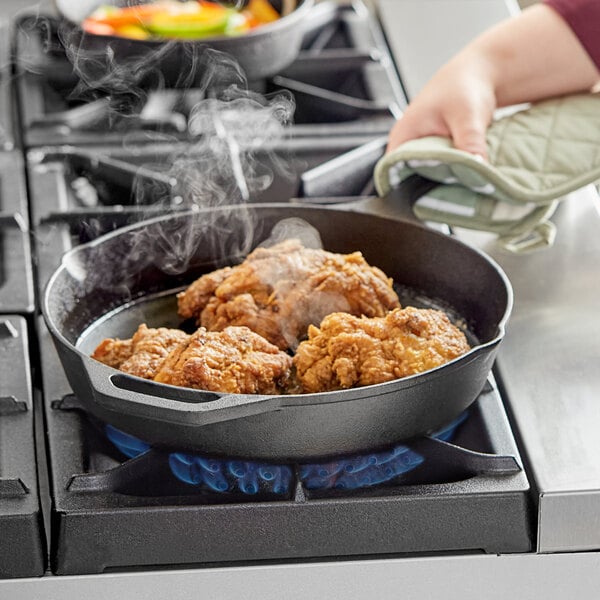
When it comes to cooking with cast iron, numerous benefits make it a popular choice among chefs and culinary professionals. Here are some key advantages of using cast iron cookware:
- Durability: Cast iron cookware is extremely durable and can last for generations when properly cared for.
- Even Heating: Cast iron distributes heat evenly, ensuring that food is cooked consistently without hot spots.
- Versatility: Cast iron cookware can be used on the stovetop, in the oven, or even over a campfire, making it a versatile option for various cooking methods.
- Non-Stick Properties: With proper seasoning, cast iron develops a natural non-stick surface, reducing the need for excessive oil or butter.
- Adds Iron to Food: Cooking with cast iron can increase the iron content of your food, which is beneficial for those who may be deficient in this essential mineral.
Types of Cast Iron Cookware
The type of cookware you use can make a significant difference in the outcome of your dishes. There are several types of cast iron cookware available, each with its own unique features and benefits. Understanding the different types of cast iron cookware can help you choose the best option for your specific cooking needs.
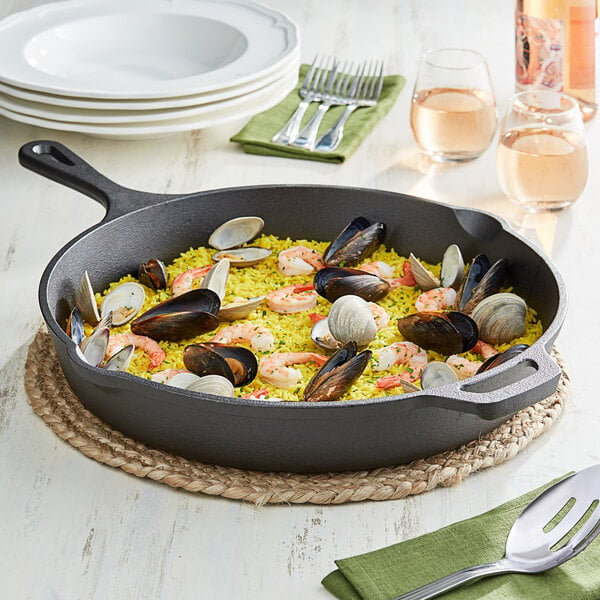
Cast Iron Skillets
Cast iron skillets are perhaps the most popular and versatile type of cast iron cookware. They are known for their even heat distribution and retention, making them ideal for searing, frying, baking, and more. Cast iron skillets come in various sizes, from small individual portions to large family-sized options.
- Incredibly versatile
- One pan can serve many purposes in different contexts
- Easily goes from oven to table for efficient service

Cast Iron Dutch Ovens
Dutch ovens are deep, heavy pots with tight-fitting lids that are perfect for slow cooking, braising, and baking. The thick walls and lids of cast iron dutch ovens help to trap moisture and heat, resulting in tender and flavorful dishes. They are great for making stews, soups, roasts, and even bread.
- Tight-fitting lid ensures heat retention while locking in moisture
- Wide variety of sizes available to meet individual needs
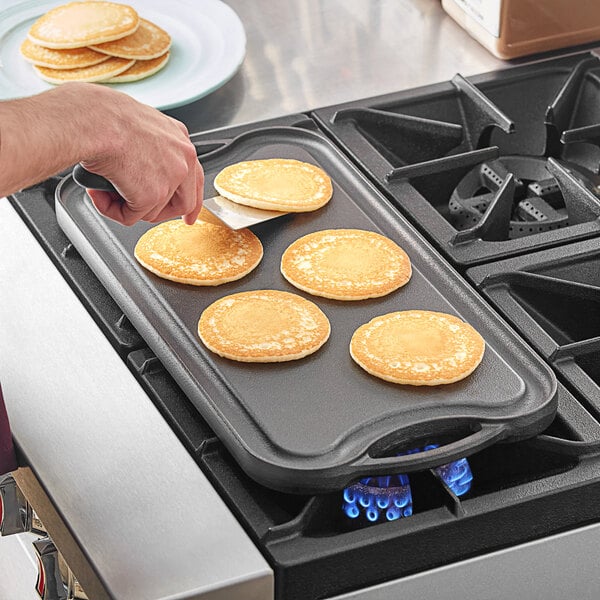
Cast Iron Griddles
Cast iron griddles are flat, wide cooking surfaces that are perfect for cooking pancakes, eggs, burgers, and more. They are designed with a smooth surface on one side for cooking delicate foods and a ridged surface on the other side for creating grill marks on meats and vegetables.
- Can saute onions, melt butter, and sear steak, chicken, or fish
- Great for serving entrees; material keeps contents warm throughout the entire meal
- Available with smooth or grooved surface
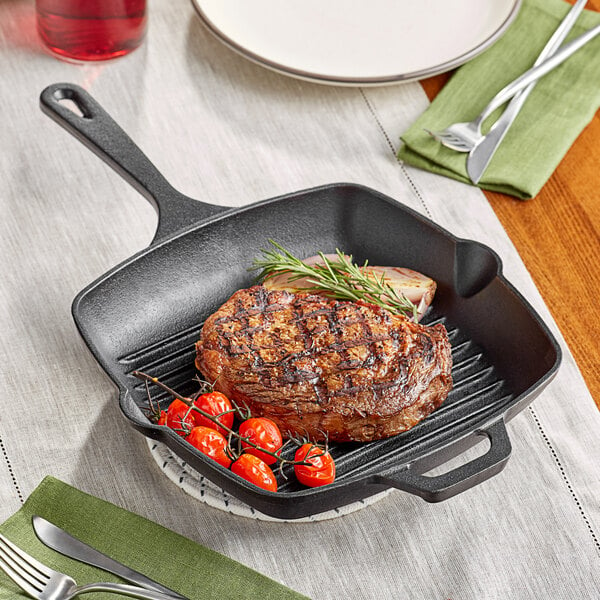
Cast Iron Grill Pans
Cast iron grill pans are designed with raised ridges to mimic the appearance of outdoor grilling indoors. They are perfect for searing meats, fish, and vegetables while allowing excess fat to drain away. Cast iron grill pans are a great alternative to outdoor grilling, especially when the weather doesn't cooperate.
- Perfect for grilling steaks, chicken, salmon, or tuna
- Ridges allow grease to drain away from the food while creating tantalizing grill marks
- Helper handles make it easy to lift larger pans
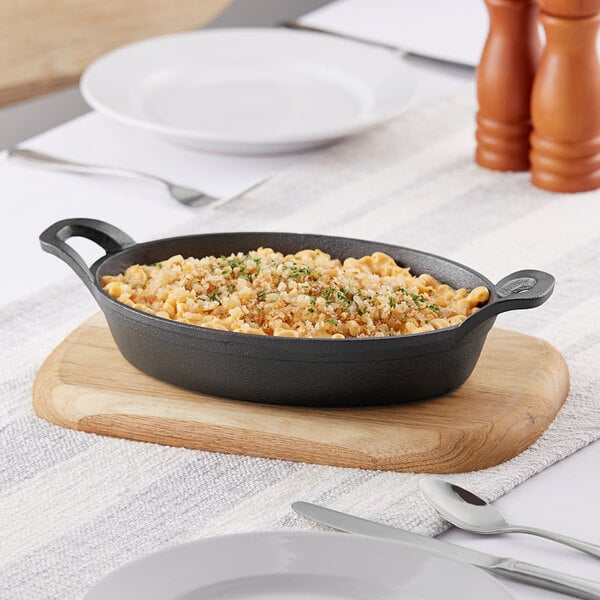
Cast Iron Casserole Dishes
Cast iron casserole dishes feature a shallow design that allows for even cooking. This makes them perfect for dishes like baked mac and cheese and pot pies. The sturdy handles on these dishes make them easy to carry and serve, making them a practical and reliable choice for any foodservice operation.
- Bakes pasta, casseroles, pot pie, baked macaroni and cheese, and vegetables
- Two handles provide easy carrying and transport
- Use with or without a lid

Cast Iron Fajita Skillets
Cast iron fajita skillets are ideal for sizzling and serving fajitas, grilled vegetables, and other hot dishes. The long handle makes it easy to transfer the skillet from the stovetop to the serving table, adding an element of excitement to your presentation. The heat retention properties of cast iron ensure that your fajitas stay hot throughout the meal.
- Serve hot and ready fajitas directly to your customers
- Keeps food warm from stove to table
- Enticing sizzling sound encourages others to order

Mini Cast Iron Servingware
Mini cast iron servingware, such as mini skillets and mini pots, are perfect for individual servings of appetizers, sides, and desserts. These miniature pieces add a rustic and charming touch to your presentation, making them ideal for serving tapas, dips, or small portions of casseroles. The heat retention of cast iron keeps your dishes warm and appetizing for longer periods.
- Bakes appetizers, desserts, side dishes, and vegetables
- Miniature size is perfect for serving individual servings
- Incredible durability and dishwasher-safe
Cast Iron Coating
One of the key features that sets cast iron apart is its coating, which plays a crucial role in its performance and maintenance. There are two main types of coatings used in cast iron cookware: pre-seasoned cast iron and porcelain enameled cast iron.
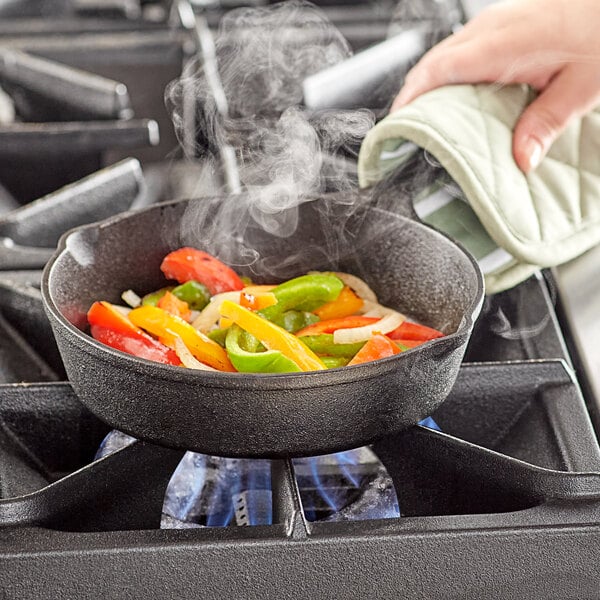
Pre-Seasoned Cast Iron Cookware
Pre-seasoned cast iron cookware comes with a layer of seasoning that is applied during the manufacturing process. This seasoning is typically a blend of oil and heat that creates a natural, non-stick surface on the cast iron. Pre-seasoned cast iron cookware is ready to use right out of the box, making it convenient for busy commercial kitchens. This coating also helps prevent rust and corrosion, extending the lifespan of the cookware.
- Offers a natural, easy-release finish that improves with use
- Pre-seasoned surface minimizes surface rusting
- Requires re-seasoning over time
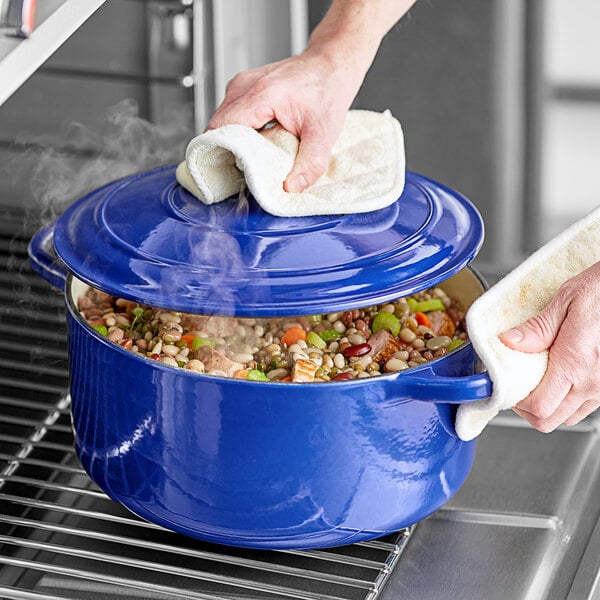
Porcelain Enameled Cast Iron Cookware
Porcelain enameled cast iron cookware features a layer of enamel coating on the surface of the cast iron. This coating adds a pop of color to the cookware and provides an additional layer of protection against rust and scratches. Porcelain enameled cast iron cookware is easy to clean and maintain, making it a popular choice for commercial kitchens looking for both style and functionality.
- Combines benefits of cast iron and beauty of porcelain enamel
- Ideal for display cooking applications
- Porcelain enamel susceptible to breakage
Cast Iron Care

Proper care and maintenance of cast iron are essential to ensure its longevity and cooking performance. Cleaning and seasoning are two crucial steps in caring for your cast iron cookware.
Cast Iron Cleaning
Cleaning cast iron cookware is a straightforward process that can be done with minimal effort. After cooking, allow the cookware to cool slightly before cleaning. Avoid using soap or harsh detergents as they can strip the seasoning from the cast iron. Instead, use a stiff brush or a non-abrasive scrubbing pad to remove food residue. For stubborn stuck-on food, you can use a paste of kosher salt and water to scrub the surface. Never put cold water in a hot or warm cast iron pan because it can cause the pan to warp or crack.
Cast Iron Seasoning
Once the cookware is clean, it's important to season it to maintain its non-stick properties and prevent rusting. Seasoning cast iron involves applying a thin layer of oil to the surface of the cast iron and heating it to create a polymerized layer that protects the cookware. To season your cast iron cookware, preheat your oven to 400 degrees Fahrenheit. Apply a thin layer of vegetable oil or shortening to the entire surface of the cookware, including the handles. Place the cookware upside down in the oven and bake for one hour. Allow the cookware to cool completely before wiping dey and storing.
Cast Iron Troubleshooting
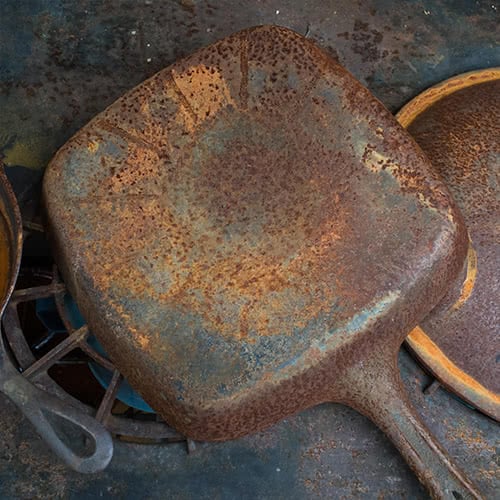
With cast iron's popularity in commercial kitchens, you may encounter issues that require troubleshooting. Understanding common problems and their solutions can help ensure your cast iron cookware remains in top condition.
Rust - Rust can develop when the protective layer of seasoning is compromised, exposing the iron to moisture. To remove rust on cast iron, scrub the affected area with steel wood. Rinse the pan and coat with oil. After removing the rust, thoroughly dry the cookware and re-season it to prevent future rusting.
Scaling - Scaling, or the buildup of mineral deposits on the surface of cast iron, can occur when water is left to evaporate on the cookware. To remove scaling, soak the affected area in a solution of equal parts water and vinegar. Gently scrub the scaling with a non-abrasive brush or sponge until it is removed. Rinse the cookware thoroughly and re-season as needed.
Sticking Food - Food may stick to the surface if the cookware is not properly seasoned or if it is not preheated adequately. To prevent food from sticking, ensure that your cast iron cookware is well-seasoned by applying a thin layer of oil and heating it until it forms a polymerized coating. Additionally, preheat the cookware before adding food to create a natural non-stick surface.
Cast Iron FAQ
Read on to learn the answers to some of the most common cast iron questions:
Cast Iron vs Non-stick Aluminum Cookware
When choosing between cast iron and non-stick aluminum cookware for commercial kitchens, there are key differences to consider. Cast iron cookware is known for its durability and ability to retain heat, making it ideal for searing and frying. It also imparts a unique flavor to dishes over time. On the other hand, non-stick aluminum cookware is light weight, easy to clean, and great for cooking delicate foods like eggs and fish. However, it may not withstand high heat as well as cast iron.
Can I Put Cast Iron in the Oven?
Cast iron cookware is extremely versatile and can be used in the oven as well as on the stovetop. Unlike many other types of cookware, cast iron can withstand high temperatures making it ideal for baking, roasting, and broiling. Whether you're making cornbread, roasting vegetables, or searing a steak, your cast iron pan can handle the heat without warping or damaging the seasoning. Just be sure to properly preheat the pan before placing it in the oven to ensure even cooking and delicious results every time.
Can You Use Cast Iron on Induction Cooktops?
Many cast iron cookware pieces are compatible with induction cooktops due to their magnetic properties. However, always check the manufacturer's guidelines to ensure compatibility with your specific cooktop.
What Not to Cook in a Cast Iron Skillet
While cast iron cookware is versatile and can be used for a wide range of dishes, it is not recommended for cooking highly acidic foods for extended periods as it can affect the seasoning. Additionally, avoid cooking delicate fish or seafood that may stick to the surface of the cookware.
Related Resources

June 2024 WebstaurantStore Coupon Code
Summer is almost here, and to celebrate Webstaurantstore is offering a variety of amazing monthly deals! In June, you'll discover incredible prices on glassware, flavoring syrups, disposable packaging supplies and much more! Take a look at our selection of sale items below and don't forget to enter the code SUMMERSALE at checkout to enjoy savings of up to 25%! We're also excited to introduce the new Webstaurant Rewards® Visa Business Card ! Sign up for a new card today and start earning rewards on every WebstaurantStore purchase. Use Coupon Code: SUMMERSALE DaVinci Gourmet Classic Passion Fruit Flavoring / Fruit Syrup 750 mL reg. $6.89 Each $5.86 Shop Now Monin Hydration Boost Syrup 1 Liter reg. $12.49 Each $11.24 Shop Now Fanale Strawberry

How to Clean a Cast Iron Pan
Whether it's been passed down through generations or just recently purchased, a cast iron grill pan is a vital tool to have in your kitchen. But once service is over, do you know how to properly clean your cast iron grill pan? With the right care, these pans can outlast even your most durable non-stick or stainless steel pans. After cooking with cast iron , follow these steps on how to clean and season a cast iron skillet to ensure your sturdy cast iron stays a staple in your commercial kitchen. Shop All Cast Iron Grill Pans How to Clean a Cast Iron Grill Pan Check out our tutorial for a visual demonstration on cleaning a cast iron grill pan: How Do You Clean a Cast Iron Pan? Below are the best ways to clean a cast-iron pan after cooking: H

How to Season and Care for Your Grill Grate
Season Your Grill Grate in 4 Simple Steps! Nothing quite says "summer" like the smell of barbecue wafting in the air. But before you fire up the grill, be sure to assess the condition of your commercial outdoor grill . Is food sticking to your grill grate? Is rust starting to form due to high-volume outdoor use? Then it's time to season your grill grate - and we'll tell you how to do it in just 4 simple steps. Whether you're firing burgers at a catered event or grilling kebabs on your poolside patio deck, this guide will ensure that you serve up success at your next barbecue! How to Season and Care for Your Grill Grate Remove grate; preheat grill to medium heat. Wash grate thoroughly using a wire brass grill brush and a decarbonizer and deg
- Topics 1367
- Industrial 55
- Troubleshooting Guides 21
- Restaurant Management 130
- Bar Management 58
- Catering Tips 37
- Bakery Management 42
- Food Trucks & Concessions 49
- Advertising & Marketing 37
- Eco-Friendly Tips 11
- Facility Layout & Design 42
- Coffee Shop Tips 29
- Installation & Maintenance 52
- Janitorial & Pest Control 30
- Safety & Sanitation 89
- Startup Tips 104
- Menu Design 10
- Kitchen & Cooking Tips 84
- Hospitality Management 24
- Pizza & Sandwich Shop Tips 36
- Smallwares 37
- Food Prep 90
- Tabletop Items 18
- Disposables 22
- Calculators & Tools 6
- Consumables 52
- Warewashing & Laundry 18
- Cooking Equipment 92
- Food Storage & Refrigeration 51
- Beverage Equipment 35
- Office Supplies 6


